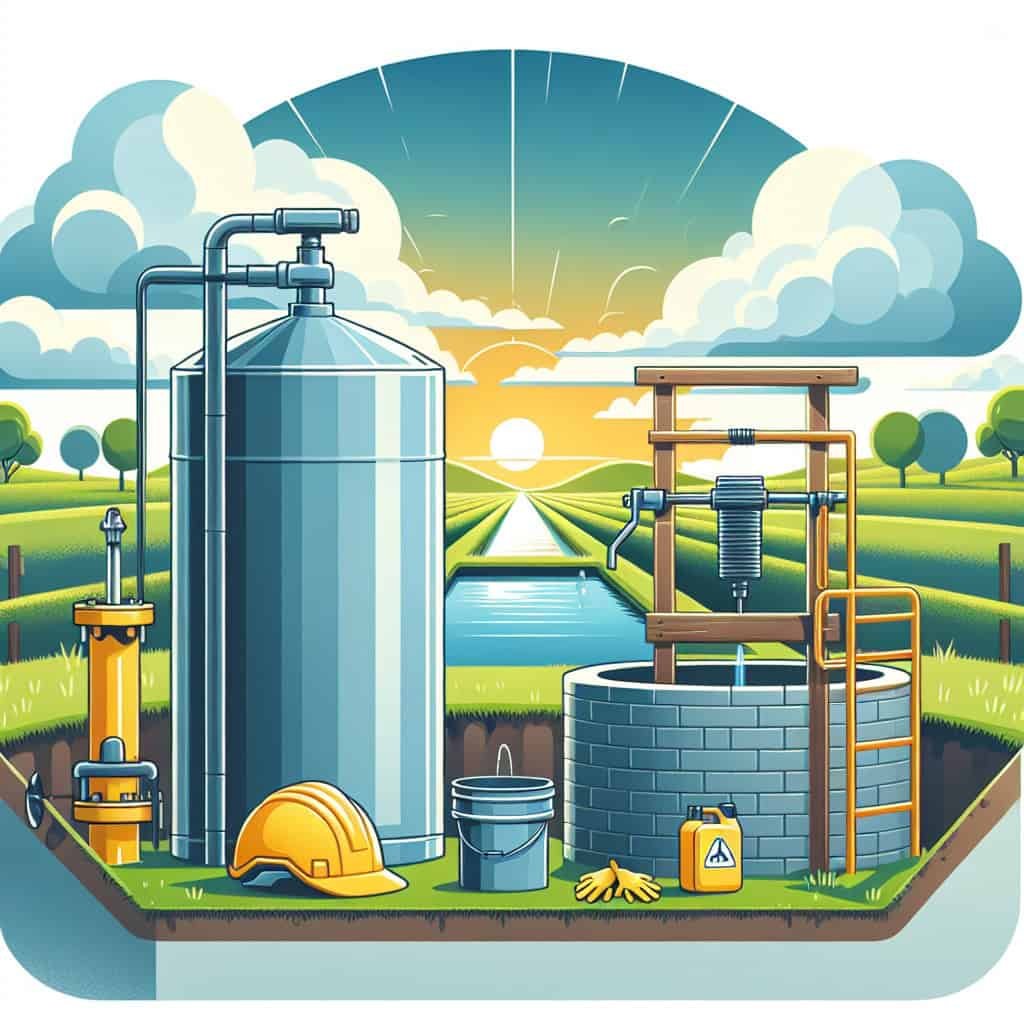Are you curious about the safety precautions you should be taking when it comes to well water in areas that require well water pressure tank maintenance? Look no further, as this article aims to provide you with the essential information. Understanding the potential risks and proper safety measures is crucial in ensuring the well-being and health of you and your loved ones. So let’s explore the important safety considerations for well water in regions where well water pressure tank maintenance is required.
Health Risks of Well Water
Well water, while often a reliable and convenient source of drinking water, can pose a number of potential health risks due to various contaminants. It’s important to be aware of these risks and take the necessary steps to ensure the safety of your well water.
Microbial Contamination
One of the primary concerns with well water is microbial contamination. Bacteria, viruses, and parasites can find their way into the water supply through various routes, such as animal feces, sewage leaks, or septic system failures. These microorganisms can cause illnesses such as diarrhea, gastrointestinal infections, and even more serious conditions like dysentery.
Regular testing is crucial to detect the presence of any harmful microorganisms in your well water. If any pathogens are detected, appropriate treatment measures should be taken to eliminate them and ensure the water is safe for consumption.
Chemical Contamination
Another significant risk associated with well water is chemical contamination. Chemicals such as pesticides, fertilizers, and industrial pollutants can contaminate groundwater and seep into well water sources. These chemicals can have detrimental effects on human health, including increased risk of cancer, organ damage, and developmental issues, especially in infants and young children.
Testing your well water for chemical contaminants is indispensable to identify any potential hazards. If hazardous chemicals are detected, appropriate treatment methods should be employed to remove or reduce their presence to safe levels. Additionally, it’s essential to be aware of any potential sources of contamination in the area, such as nearby agriculture or industrial activities.
Radon Gas
Radon is a radioactive gas that occurs naturally in the environment, and it can dissolve in water and enter a well water supply. Long-term exposure to radon can be harmful and is known to increase the risk of lung cancer. It’s important to test well water for radon levels and take action if they exceed recommended limits.
If elevated radon levels are detected, treatment options such as aeration or granular activated carbon filtration can effectively remove the gas from the water supply and reduce health risks.
Heavy Metals
Heavy metal contamination in well water is a concern in certain regions, particularly those with mining or industrial activities. Metals such as lead, arsenic, mercury, and cadmium can potentially find their way into groundwater and pose significant health risks. These metals can cause a range of health issues, including neurological damage, kidney damage, and various cancers.
Regular testing for heavy metals is crucial to identify any potential contamination in your well water. If elevated levels are found, treatment options such as reverse osmosis, activated carbon filtration, or ion exchange can effectively remove the heavy metals and ensure safe drinking water.
Pesticides and Fertilizers
In agricultural areas, the use of pesticides and fertilizers can lead to the contamination of groundwater and, subsequently, well water sources. These chemicals can pose a risk to human health, including disruption of hormonal systems, increased risk of cancer, and developmental issues in children.
Testing well water for pesticide and fertilizer residues is essential to determine the presence of these contaminants. If detected, treatment options like activated carbon filtration, ozonation, or advanced oxidation processes can help remove these chemicals and make the water safe for consumption.
Importance of Well Water Pressure Tank Maintenance
Maintaining your well water pressure tank is crucial for ensuring the quality and reliability of your water supply. Neglecting proper maintenance can lead to a host of problems and potentially jeopardize the safety of your water.
Maintaining Water Quality
Regular maintenance of your well water pressure tank is essential to prevent the buildup of sediment, sludge, or bacteria that could contaminate the water. Over time, these deposits can accumulate and affect the taste, odor, and even the clarity of your well water. By inspecting and cleaning the tank periodically, you can ensure that the water remains of high quality and free from any potential contaminants.
Optimizing Water Pressure
Well water pressure tanks play a critical role in maintaining a consistent water pressure throughout your plumbing system. If the pressure tank is not properly maintained, it can lead to issues such as low water pressure, inconsistent flow, or even complete loss of water supply. Regular maintenance, including checking for leaks and proper functioning of the pressure switch, can help optimize water pressure and ensure smooth operation of your water system.
Preventing Equipment Failure
A well water pressure tank that is not adequately maintained can be prone to various problems and may eventually fail. A compromised tank can lead to costly repairs or the need for a complete replacement. By regularly inspecting the pressure tank, including checking for rust or corrosion, you can identify any potential issues before they escalate into major problems. Timely maintenance can help prevent equipment failure and extend the overall lifespan of your well water system.
Extending Lifespan of System
A well water system is a significant investment, and proper maintenance is key to maximizing its lifespan. Regular inspection and cleaning of the pressure tank can help prevent the accumulation of debris or sediment that could cause clogs or damage to other components of the system. By taking care of your pressure tank, you can ensure the longevity and efficiency of your well water system, ultimately saving you time and money in the long run.

Factors Affecting Well Water Safety
The safety of well water can be influenced by various factors, both natural and man-made. It’s essential to understand these factors to assess the potential risks associated with your well water supply.
Geographical Location
The geographical location of your well can have a significant impact on the safety of the water. Factors such as local geology, climate, and proximity to potential sources of contamination can affect the quality of groundwater. Some regions may naturally have higher levels of certain contaminants, and being aware of these local conditions can help inform appropriate testing and treatment measures.
Well Construction and Depth
The construction and depth of your well can also play a role in its vulnerability to contamination. If the well is not properly constructed or sealed, it can provide an entry point for contaminants to enter the water supply. Additionally, the depth of the well can determine the extent to which it draws water from different geological layers, potentially impacting the quality and safety of the water.
Ensuring that your well is constructed and maintained according to recommended standards is crucial to minimize the risk of contamination and maintain the safety of your well water.
Distance from Contaminant Sources
The proximity of your well to potential sources of contamination is another important consideration. Wells located near septic systems, agricultural fields, or industrial facilities may be more susceptible to contamination from bacteria, chemicals, or pollutants. Understanding the potential sources of contamination in your area and their distance from your well can help inform appropriate preventive measures and regular testing.
Aquifer Vulnerability
The vulnerability of the aquifer that supplies your well water can also impact its safety. Different aquifers have varying levels of protection from contaminants, depending on factors such as soil composition, geological structure, and recharge rates. Understanding the vulnerability of your aquifer can help assess the potential risks and inform appropriate testing and treatment measures.
Proximity to Industrial Areas
If your well is located in close proximity to industrial areas, there may be an increased risk of chemical contaminants in the water supply. Industrial activities can release pollutants into the air and soil, which can then seep into the groundwater. Being aware of nearby industrial activities and their potential impact on your well water quality can help guide appropriate testing and treatment measures.
Regular Testing and Treatment
Regular testing and treatment of well water are vital to ensure its safety and minimize the risks associated with potential contaminants. By implementing a comprehensive testing and treatment plan, you can take proactive steps to protect your health and the health of your family.
Waterborne Pathogen Testing
Testing well water for the presence of waterborne pathogens, such as bacteria, viruses, and parasites, is crucial to identify any potential health hazards. Sampling should be conducted at regular intervals, and different tests can be performed to assess the microbial quality of the water. If pathogens are detected, appropriate treatment methods, such as chlorination or UV disinfection, should be employed to eliminate the microorganisms and ensure safe drinking water.
Testing for Chemicals
Regular testing for chemical contaminants is also essential to assess the safety of your well water. Various tests can be conducted to detect the presence of pesticides, fertilizers, heavy metals, and other chemicals. If hazardous levels of contaminants are identified, treatment options such as activated carbon filtration, reverse osmosis, or ion exchange can effectively remove or reduce these chemicals to safe levels.
Radon Testing
Radon gas can dissolve in well water and pose health risks if present at elevated levels. Testing well water for radon is crucial, and if levels exceed the recommended limits, appropriate treatment methods like aeration or granular activated carbon filtration should be implemented to remove the gas and minimize health risks.
Heavy Metal Testing
Testing well water for heavy metals is important, particularly in regions with mining or industrial activities. Elevated levels of metals such as lead, arsenic, mercury, or cadmium can pose serious health risks. Identifying and treating heavy metal contamination in well water can be done through methods like reverse osmosis, activated carbon filtration, or ion exchange.
Treatment Options
In addition to testing, various treatment options are available to address specific water quality issues. These can include chlorine or chloramine disinfection for microbial control, activated carbon filtration for removing chemicals, reverse osmosis for removing heavy metals, and UV disinfection or ozone treatment for additional microbial control. It’s important to consult with a water treatment professional to determine the most suitable treatment method based on your specific well water quality.

Inspecting and Cleaning the Pressure Tank
Regular inspection and cleaning of the well water pressure tank are essential to maintain its functionality and ensure the long-term performance of your water system. By following a proper maintenance routine, you can prevent potential problems and prolong the lifespan of your pressure tank.
Inspecting for Rust or Corrosion
Regularly inspecting the pressure tank for signs of rust or corrosion is crucial. Rust or corrosion on the tank’s exterior or interior can weaken the tank’s structural integrity and potentially lead to leaks or failure. If any rust or corrosion is observed, appropriate action should be taken, such as applying rust-resistant paint or considering a replacement if significant damage is present.
Checking for Leaks
Inspecting the pressure tank for leaks is an important aspect of maintenance. Leaks can lead to water loss, reduced water pressure, or damage to other components of the water system. Thoroughly inspect all connections, valves, and fittings for any signs of leakage. If any leaks are detected, prompt repairs should be made to prevent further damage and ensure the efficiency of the system.
Flushing the Tank
Flushing the pressure tank periodically helps remove sediment or debris that may have settled at the bottom. Sediment buildup can reduce the tank’s capacity and potentially contaminate the well water. Flushing the tank involves draining a portion of the water to remove any accumulated sediment or sludge. This process should be performed carefully to avoid any damage or disruption to the water system.
Removing Sediment or Sludge
If significant sediment or sludge is present in the pressure tank, it may be necessary to clean the tank more thoroughly. This can involve completely draining the tank, removing any accumulated sediment, and using a cleaning solution or water treatment additives to disinfect and remove any remaining contaminants. Professional assistance may be required for extensive tank cleaning to ensure proper procedures are followed.
Preventing Contamination
Preventing contamination of well water is crucial for maintaining its safety and quality. By implementing proper preventive measures, you can minimize the risk of introducing contaminants into your water supply.
Well Caps and Covers
Installing and maintaining a secure and properly fitting well cap or cover is essential for preventing insects, rodents, or other animals from entering the well and potentially introducing contaminants. Well caps and covers should be kept in good condition, with seals intact and screens free from debris or damage. Regular inspection and repairs should be performed to ensure the integrity of the well enclosure.
Sealing Access Points
Properly sealing all access points to the well can help prevent the entry of surface water or potential contaminants. This includes sealing around pipes, cables, or conduits that enter the well casing. Ensuring a watertight seal and periodic inspection for any signs of damage or deterioration is crucial for maintaining the integrity of the well system.
Maintaining a Protective Wellhead Area
Maintaining a protective wellhead area around the well is important to prevent potential sources of contamination. This area should be kept free from vegetation, animal waste, fertilizers, pesticides, or other potential contaminants. Creating a buffer zone around the well and practicing proper land management techniques can help protect the water supply from potential pollutants.
Preventing Backflow
Backflow, which occurs when water flows in the reverse direction, can be a potential source of contamination in well water. It’s important to install and maintain appropriate backflow prevention devices, such as check valves or backflow prevention assemblies, to prevent the backflow of contaminated water into the well. Regular inspection and testing of these devices are crucial to ensure their proper functioning and effectiveness.

Disinfection Procedures
Disinfection of well water is a critical step in ensuring its safety and eliminating any potential microbial contaminants. Various methods can be used to disinfect well water and maintain its quality.
Chlorination
Chlorination is a commonly used method for disinfecting well water. This process involves adding chlorine to the water to kill any bacteria, viruses, or other microorganisms present. It’s important to follow proper dosing guidelines and allow sufficient contact time for the chlorine to be effective. After chlorination, it’s necessary to test the water to ensure the chlorine levels have been reduced to safe levels before use.
Shock Chlorination
Shock chlorination is a more intensive form of chlorination used to disinfect heavily contaminated wells. This involves temporarily increasing the chlorine concentration to eliminate any potential bacterial or microbial growth. Shock chlorination should be done with caution, following proper guidelines and safety procedures, and may require professional assistance.
UV Disinfection
UV disinfection is a non-chemical method for killing or inactivating microorganisms in well water. UV light is used to disrupt the DNA of bacteria, viruses, and other pathogens, rendering them unable to reproduce or cause harm. UV systems should be properly sized, installed, and maintained to ensure effective disinfection. Periodic bulb replacement and regular monitoring of UV intensity are essential for the ongoing efficiency of the system.
Ozone Treatment
Ozone treatment is another chemical-free method for disinfecting well water. Ozone is a powerful oxidizing agent that can effectively destroy a wide range of microorganisms. Ozone generators are used to produce ozone gas, which is then injected into the well water. Proper installation, monitoring, and maintenance of the ozone system are essential for effective disinfection and maintaining the safety of the water supply.
Maintaining and Testing the Water Treatment System
If you have a water treatment system in place, maintaining and regularly testing it is essential for ensuring its proper functioning and the continued safety of your well water.
Replacing Filters
If your water treatment system includes filtration, it’s important to regularly replace the filters according to the manufacturer’s recommendations. Over time, filters can become clogged with sediment, chemicals, or other contaminants, reducing their effectiveness. Regular replacement of filters ensures optimal performance and helps maintain the quality of your treated well water.
Calibrating Equipment
Certain water treatment systems may require periodic calibration to ensure accurate operation. Calibration ensures that the system is correctly measuring and dosing treatment chemicals, regulating pressure, or controlling other important parameters. Following manufacturer guidelines and regularly calibrating equipment is crucial to maintain the safety and effectiveness of your water treatment system.
Ensuring Proper Functioning
Regular monitoring and inspection of your water treatment system are essential to ensure its proper functioning. This includes checking for any leaks, unusual noises, or changes in water quality. If any issues or malfunctions are detected, prompt action should be taken to address the problem and prevent potential risks to the safety of your well water.
Periodic Water Quality Checks
Regular water quality checks are important to assess the overall performance of your water treatment system and ensure the continued safety of your well water. Regular testing can help identify any potential deterioration in water quality or treatment efficacy. It’s advisable to consult with a water treatment professional to determine the appropriate testing frequency and parameters based on your specific well water system.

Emergency Response Plan
Having an emergency response plan in place is crucial for effectively addressing any unforeseen issues that may arise with your well water supply. Being prepared can help minimize potential risks and ensure prompt action in emergency situations.
Identifying Emergency Situations
It’s important to identify and understand potential emergency situations that could occur with your well water supply. These can include sudden water loss, significant changes in water quality, or any other issues that may affect the safety or availability of your well water. By considering different scenarios, you can develop an effective emergency response plan tailored to your specific circumstances.
Establishing a Communication Plan
Establishing clear communication channels and contacts is crucial for effective emergency response. Ensure that all household members are aware of emergency contact numbers, including local health authorities or water treatment professionals. Having a communication plan in place can facilitate the reporting of any emergencies, allowing for timely action and appropriate assistance.
Backup Water Supply
In the event of an emergency or interruption in well water supply, having a backup water supply is essential. This can include storing an adequate supply of bottled water or maintaining access to an alternative water source, such as a nearby community water system or a neighbor’s well. Being prepared with a backup water supply ensures access to safe drinking water during any disruptions in your well water system.
Contacting Professionals
If an emergency situation occurs or you suspect significant contamination or damage to your well water system, it’s important to contact professionals for assistance. Water treatment experts, health authorities, or plumbers experienced in well water systems can provide guidance and support in resolving the issue and ensuring the safety of your well water.
Education and Awareness
Education and awareness are key to maintaining the safety of your well water supply. By staying informed and actively involved in your well water system, you can take the necessary steps to protect your health and that of your family.
Knowing the Warning Signs
Being knowledgeable about the warning signs of potential issues with your well water supply is crucial. This can include changes in water quality, unusual tastes or odors, or any visible signs of contamination. Regularly inspecting and monitoring your well water can help detect any potential problems early, allowing for timely action and appropriate treatment.
Educating Household Members
Educating all household members about the importance of well water safety and the proper use and maintenance of the water system is essential. This includes teaching children about the risks of contamination and the importance of not tampering with or damaging any components of the well system. By promoting awareness and responsible water usage, you can help ensure the long-term safety of your well water supply.
Keeping Up with Regulations
Staying informed about the regulations and guidelines pertaining to well water safety in your region is crucial. Regulations can vary depending on location, and keeping up to date with any changes or requirements can help you meet the necessary standards for maintaining a safe well water supply. This can include regular testing, maintenance, and any other recommended measures specific to your region.
Participating in Community Initiatives
Engaging with your local community and participating in initiatives related to well water safety can be beneficial for everyone. This can include attending community meetings or workshops, joining local associations or groups focused on water quality, or sharing knowledge and experiences with other well owners. By working together and exchanging valuable information, you can contribute to a safer and healthier water supply for your community.
In conclusion, maintaining the safety of well water in regions with well water pressure tank maintenance requires a comprehensive approach. Understanding the health risks associated with well water, implementing proper maintenance procedures, considering various factors affecting well water safety, regular testing and treatment, inspecting and cleaning the pressure tank, preventing contamination, implementing disinfection procedures, maintaining and testing the water treatment system, having an emergency response plan, and promoting education and awareness are all essential components of ensuring the safety of your well water supply. By following these guidelines and being proactive in well water management, you can enjoy a reliable and safe source of drinking water for you and your family.

